Interview
Maren Beck of Above the Fray Hill Tribe Arts
Cathy Koos
(all photos courtesy Maren Beck)
I recently had the pleasure of a Zoom chat with the sparkling, enthusiastic Maren Beck of Above The Fray Hill Tribe Arts. Maren and her partner, Joshua Hirschstein, are not only business partners but life partners, as well.
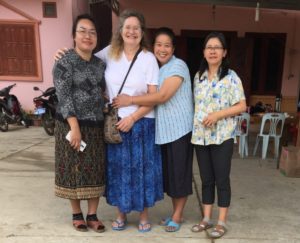
Figure 1 Maren Beck and local weavers
Maren came to textiles early in life with a “house filled with looms.” After graduating from Wellesley, Maren made her first visiting to Southeast Asia with Josh in 1984. Maren became smitten, in her words, with the vast array of woven goods. Not having a written language until recently, the silk textiles tell the mythology and stories of the hill tribe cultures.
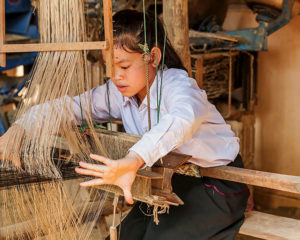
Figure 2 photo by Joe Coca for “Silk Weavers of Hill Tribes Laos”
Who are the Hill Tribes? About one thousand groups came from China many years ago and were effectively left alone due to the rough geography. After the Vietnam war, there were about 160 ethnic groups in the Lao Peoples Democratic Republic. Maren works primarily with Lao people in the northeast Hoaphan province.
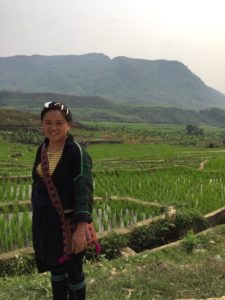
Figure 3 Thi poses in front of her family rice fields.
The seed was afforded thanks to a grant from WARP (Weaving a Real Peace)
The hill tribes are primarily an agrarian society with the men farming and the women weaving. Thai Buddhists and Lao Animists make up the population and the textiles reflect both of those religions. Mythological creatures and ancestors abound in the weavings and tell us a rich story. The shaman use these weavings in their ceremonies.
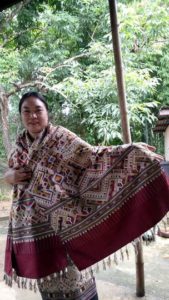
Figure 4 Phout models a new silk shaman cloth
Shaman Cloths. Maren primarily brings back shaman cloths, love tokens, and baskets for resale, with the profits going back directly to the individual weaver. When asked about the sacredness of the shaman cloth, Maren said, “Oh, the weavers laughed and said only the shaman knew how to invoke the spirits!”
Shaman cloths are three basic sizes – blanket, shawl size, and narrow. The narrow cloth is 5-6” wide and strongly resemble a liturgical stole not unlike those a priest or minister would wear. In fact, Maren shared that a woman priest purchased three for just that purpose.
Love tokens. Also called auspicious cloths, the women weave intricate mythological creatures into these approximately 10 x 10” textiles. These will protect the recipient as they travel and can also be given to a visitor to apologize for disruptions to their family, or disruptions caused by a marriage arrangement.
Baskets. Baskets are also another product Maren brings back. “I prefer to buy used baskets in the market and not in homes, as they may still be in use. I love the gorgeous patinas from the cookfire smoke.” Baskets are often hung over the cookfire to cure the bamboo and rattan, giving strength and flexibility. The smoke also keeps out beetles. Maren has recently noticed an infiltration of Chinese plastic goods molded and colored to look like the rattan and bamboo baskets.
The Hill Tribe people. Women are the primary weavers and girls as young as seven begin to weave when the school day is over. The girls learn the family stories while weaving and mythology of their culture. Maren “is able to provide a market for the women and they can make the equivalent of a middle- class income.”
Figure 5 A weaver in Ban Tao, Laos creates a colorful door curtain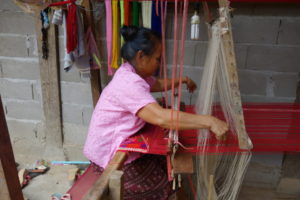
The men are the farmers raising field crops and as sericulturists farming the mulberry trees. They raise Bombyx mori, the domestic silkworm. Maren told me, “the women reel the silk directly from the worms in the water bath. Using this method can yield ¼ mile of strong silk!” Natural dyes are still employed, using the old methods.
“I try not to influence the weaving, and instead buy what is already woven and available,” said Maren. “But the Hill tribes are savvy marketers, and they are very attuned to buying behaviors.” Maren travels to Lao and Viet Nam once or twice a year.
School is mandatory up to sixth grade, with these primary schools located centrally between villages. Students going beyond sixth grade must travel to a provincial capital and board with relatives. So, if a young girl begins her weaving career after school at the age of seven, she will be quite proficient by the time she leaves school at 12.
Looms are located under the elevated homes and have a large head frame that holds the reed and beater. Looms are set up for plain weave and have vertical pattern heddles.
Viet Nam. Maren also visits Viet Nam for textiles. Each year during Tet, the New Year, people purchase a new set of clothing, so they do not bring last year’s bad luck into the new year. So, the old clothing is given new life as it is upcycled into bags, wallets, and wall hangings.
Spiritual connection. Whether through shaman cloths, love tokens, or work baskets, Maren relates “the textiles of the Hill Tribes are real – not made for market!”
You can find out more about Above the Fray and details on the textiles on website at https://hilltribeart.com/